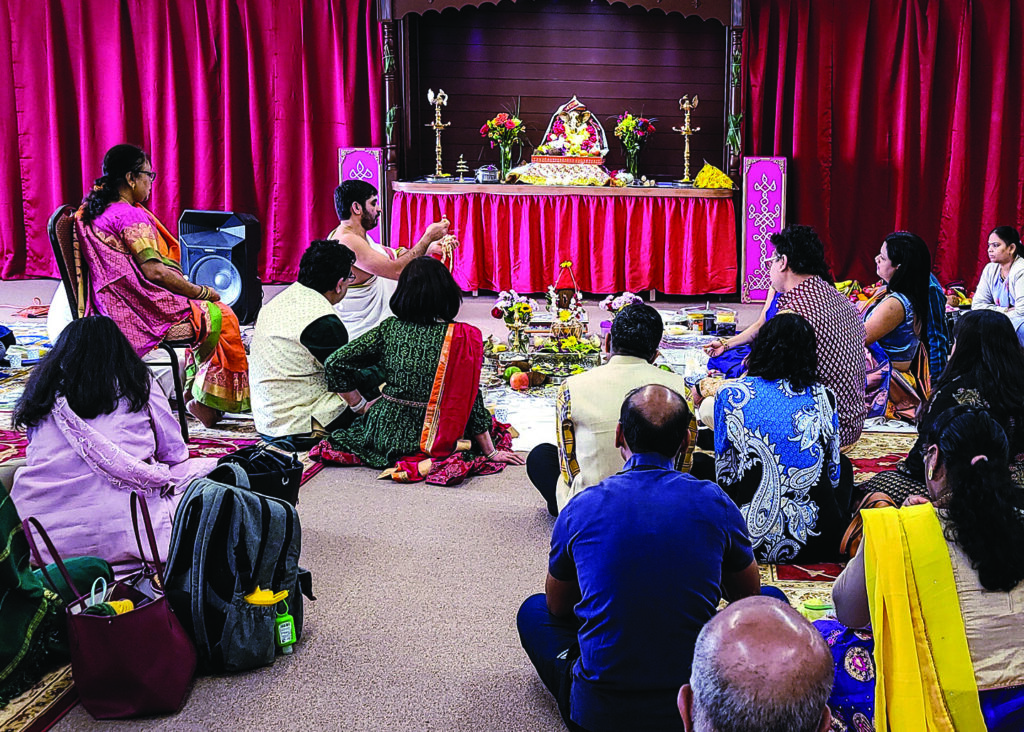
Pandit Gowtham Bhat conducts the prayers inaugurating the new temple on Sunday, Jan. 15 — Makar Sankranti on the Hindu calendar. (Photo/Nancy Hanson.)
Nancy Edmonds Hanson
Followers of the world’s oldest religion have inaugurated Fargo-Moorhead’s newest place of worship, creating a center for Hindu worship, teaching and celebrations.
About 100 men, women and children took part in a prayer service welcoming the new center on Sunday. Located at 16 Fourth Ave. N. — the former site of Melberg’s Christian Books — the temple hosted chanting, prayer and rituals conducted by visiting Pandit (priest) Gowtham Bhat of Maple Grove, Minnesota. The Moorhead temple is the fifth established in Minnesota since the first, in Minneapolis, opened its doors in 2009. A total of five now welcome worshipers in the Twin Cities; another opened in Rochester two years ago. The only other in the Upper Midwest was established in Sioux Falls, South Dakota, in 2018.
The Indian-American community in Fargo-Moorhead includes some 200 families. While believers commonly maintain altars and pray in their homes, the mandir (temple) serves as a center of the community — one that local Hindus have long desired, eliminating the long drive to the Twin Cities.
“The temple is a very important part of the Hindu religion,” explains Vijay Gaba, MD, a member of the board of directors along with physicians Om Prakash Sharma, Nagesh Chalasani and Nita Sharma, and Swati Kumar, DDS. “We use it not only for community worship and prayer but for social interaction, not only among adults but also children. While there is no requirement for holding scheduled weekly services, it is a great way to teach all who practice the Hindu, Sanatan Dharam and Vedic philosophies more about our traditions and the reasoning behind them.” The group plans to schedule regular times for events, however, because they presently have no staff or priest to keep it open every day. For the time being, it will be open from 11 a.m. and 1 p.m. on Saturdays and Sundays.
Referring to the Indian-American physicians, professors and professionals who serve in F-M hospitals, higher education and technology companies, he adds, “There’s a lot of turn-over here for two reasons. One, of course, is the winter. The other has been the lack of a temple they can call their own. This is something we have talked about for 20 years. Now it has finally become reality.”
The dream began to takeshape about a year ago when the Indian-American Association of Fargo-Moorhead formed a committee to lay plans. Kumar, who leads the executive committee, says that thanks to generous leadership gifts, they have reached nearly 56% of their fund-raising goal of about $500,000. The group’s website displays a quote from the Atharva Veda: “Earn with hundred hands and donate with thousand.” Other members of the committee include Kavitha Gundala, Dakshita Gupta and Vijay Tulsidhar.
At first the logistics seemed difficult — especially, Gaba says, because many Hindus were not sure they would retire here. “The spark was lit when one respected member of our community, Dr. O.P. Sharma, took the initiative,” he reports. “He soon convinced others to join him.” He emphasizes the help received from the city of Moorhead in green-lighting the project, making conversion of the former commercial space possible.
Sunday was an especially auspicious day for the enthusiastic faithful to inaugurate their mandir. They were observing Makara Sankranti, celebrating India’s winter harvest. As the visiting pandit (priest) led chants of sacred mantras in the Sanskrit and Hindi languages, foods and flowers were offered to the sacred deities. The congregation sat or knelt on carpets. In another room, youngsters enjoyed a combination of education and boisterous fun.
At ceremony’s end, the congregation — many women dressed in intricately colored and embroidered saris — moved into another room, where they shared a bountiful lunch of homemade Indian delicacies, from naan and peppered or cumin-infused rice to a selection of curries and and halwa.
In the past, Gaba notes, the community has gathered for worship, teaching and festivals in members’ homes or rented church or school facilities. “This temple will be a big attraction for Hindu families from India because now they have a place to call their own,” he says. “This truly kindles memories of temples and gatherings in India. It helps children who grew up here in the U.S. to learn more about the culture and religion of their parents. And it will become a place socializing among people who share that background.”
He adds, “It also gives new immigrants from India a reason to not move from the F-M area to bigger cities to find other families who immigrated many years ago and still live here.
“Immigrants have traditionally come to this area for research and teaching jobs in universities and for employment in the region’s hospitals and clinics. But in the last 20 years, the jobs have expanded to the tech and computer industries, as well as small businesses.”
He predicts at least half of the local Hindu community will come together at the new temple, as well as others from the surrounding region. Families from Grand Forks, Valley City, Bismarck, Detroit Lakes and other surrounding towns have already been involved in Hindu and Indian cultural activities here. Now they have a permanent home.


